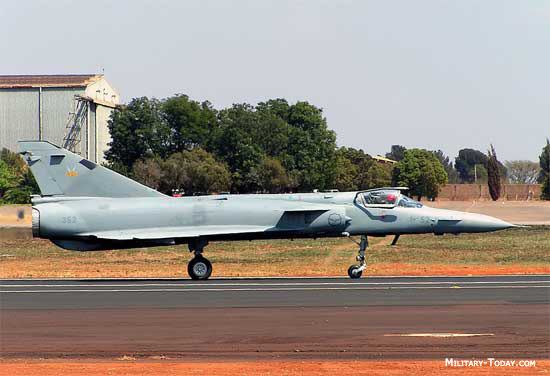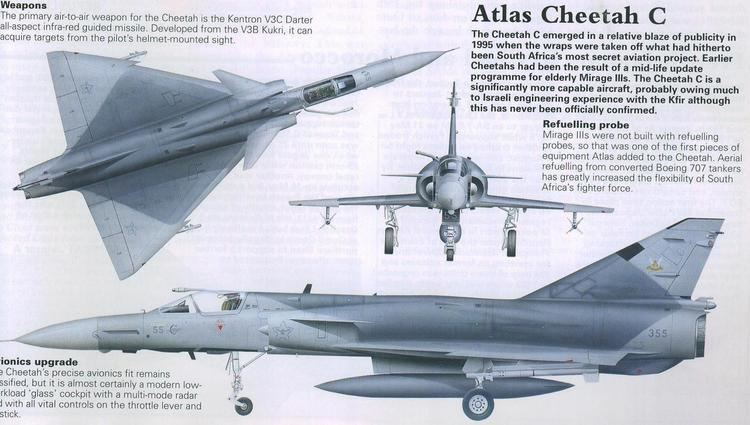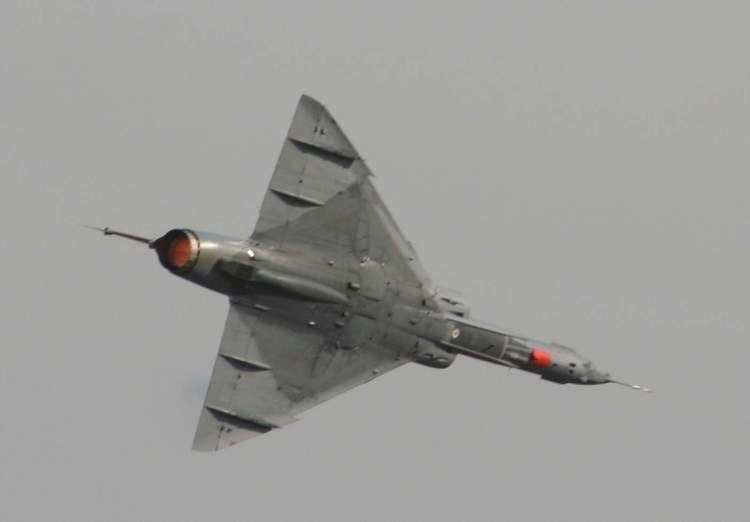Top speed 2,350 km/h Range 1,300 km Length 16 m | Cruise speed 956 km/h Wingspan 8.22 m Unit cost 15,000,000–15,000,000 USD | |
 | ||
Atlas cheetah
The Atlas Cheetah is a South African fighter aircraft developed for the South African Air Force (SAAF), and currently operated by the Ecuadorian Air Force (FAE). It was developed as a major upgrade of the Dassault Mirage III by the Atlas Aircraft Corporation (later Denel Aviation) in South Africa and is based on the IAI Kfir. Three different variants were created, 16 dual-seat Cheetah D, 16 single-seat Cheetah E and 38 single-seat Cheetah C. The Cheetah Es were retired in 1992, and the Cheetah Cs and Cheetah Ds in April 2008, being replaced by the Saab Gripen. A limited number are still operated in South Africa as flight test aircraft.
Contents
- Atlas cheetah
- Atlas cheetah aerial display
- Development
- Operational history
- Cheetah C
- Cheetah D
- Cheetah E
- Cheetah R
- Operators
- Specifications Cheetah C
- References

Atlas cheetah aerial display
Development

The Atlas Cheetah programme grew out of South Africa's requirement for a modern fighter and strike aircraft in the 1980s. There was a need for more advanced aircraft to attain an edge over the ever more sophisticated Soviet aircraft such as the MiG-23 being supplied to Angolan and Cuban forces in action against South African forces in the Border War. Furthermore, the increasing cost of maintenance due to sanctions and the age of the aircraft used by the SAAF had to be addressed. The arms embargo imposed at the time by United Nations Security Council Resolution 418 prevented South Africa from purchasing new aircraft from other countries, thus making an upgrade of existing aircraft the only option. By this stage, the South African aviation industry had reached the level of technical capability to make a large and sophisticated upgrade possible, leading the SAAF to make the only possible decision: to extensively upgrade one of the existing types in service while an advanced indigenous fighter, the Atlas Carver, was under development.

At the time the SAAF's fast jet fleet consisted of Dassault Mirage III (EZ/CZ/BZ/DZ/D2Z/RZ/R2Z) and Mirage F1 (AZ/CZ) aircraft. Though the Mirage F1s were the most modern of the fleet, having been delivered from 1977 onwards, they were the primary element of South Africa's air defence and strike fleet and to withdraw them for an upgrade would have left an unacceptable gap in its air defence and strike capability. In addition there were already a few successful Mirage III upgrades from which to learn, such as the Israeli Kfir and Mirage III NG, so the SAAF's Mirage III fleet was chosen as the basis for the upgrade, to be known initially as Project Cushion.

The work was carried out by Atlas Aviation (formerly Atlas Aircraft Corporation and lately Denel Aviation), using expertise partly gained by recruiting technicians from Israel's aborted IAI Lavi fighter project. The upgrade consisted of a complete refurbishment of the airframe down to zero hours (in which some 50% of the original airframe was said by Atlas to have been replaced), the fitting of non-moving canards (Cheetah D & E having slightly smaller (70%) canards than that of the Cheetah C and Kfir) just aft of the engine intakes, two new stores pylons at the wing roots, an aerial refuelling probe, new ejection seats, a more powerful engine (the SNECMA Atar 9K50C-11 [upgraded in South Africa]) in the D and C variants, a new main wing spar along with a new "drooping" leading edge and a dog-tooth incision on each wing, modern elevons controlled by a twin computer flight control system, and strakes on the nose to improve the Cheetah's high-Angle of attack (AoA) performance. The aerodynamic refinements alone increased the turn rate by 15%, increased the AoA, reduced the minimum airspeed to 100 kt and increased maximum take-off weight by 700 kg. However, it also resulted in a 5% decrease in maximum level speed and acceleration.

In addition, a highly sophisticated avionics, radar, EW and self-protection suite was installed, necessitating a lengthening of the nose. This entailed the fitting of an EW suite which included missile and radar warning sensors. Other features included the aircraft's self-protection system, which consisted of electronic jammers and chaff/flare dispensers that engaged automatically; the integration of a South African helmet-mounted sight and an oversized head-up display (HUD); the installation of an advanced Pulse-Doppler radar and sophisticated cockpit instrumentation.

Most leading aviation publications suspect that Israel Aircraft Industries was involved in at least the initial stages of the upgrade, and that some of the upgrade's components were sourced from Israel. At least five IAI Nesher fighters may have been acquired from the Israeli Air Force for Cheetah trials and later absorbed into the existing fleet.
Operational history
First to roll off the production line were the Cheetah Ds and Cheetah Es, though it appears the Cheetah Ds had production priority. The first aircraft to be converted was a Mirage IIID2Z, no.845, which arrived at Atlas in April 1983. The date of completion is unknown, but the first Cheetah D was officially unveiled on 16 July 1986, by which time a number of Cheetah Ds had already entered service with 89 Combat Flying School at AFB Pietersburg, though the type was only declared operational in 1987. The second and third aircraft to be delivered to Atlas were both Mirage IIIEZs, and the resulting Cheetah Es went into service with 5 Squadron at AFB Louis Trichardt. 16 of each type were in service by 1991 when the Cheetah D and E conversion lines closed, by which time the first of the 38 Cheetah Cs were being converted, with the first being rolled out in January 1993. All the Cheetah Cs entered service with 2 Squadron, also at AFB Louis Trichardt. None of the Cheetah variants ever saw combat in the Border War, so their performance was never tested against the dominant fighter in the conflict, the MiG-23. The Cheetah Es were used as permanent interceptor aircraft, with a minimum of two aircraft on round-the-clock alert status, until the end of the Border War in 1989.
With the entering into service of the Cheetah C, the Cheetah Es were withdrawn from service and 5 Squadron was disbanded in 1992. Soon afterwards, 89 Combat Flying School was also disbanded, and all the Cheetah Ds were transferred to 2 Squadron, where they remained until retirement in 2008.
Two Cheetah Ds are still operated in South Africa by the SAAF on behalf of Denel Aviation at the Overberg Test Flight and Development Centre as systems test aircraft.
Cheetah C
The Cheetah C was the final development in the Cheetah series and was the only fighter aircraft in service with the SAAF until replaced by the Saab JAS 39 Gripen in 2008. In addition to the upgrades described above, the Cheetah C incorporated more sophisticated avionics and navigation suite and an improved pulse-doppler multi-mode radar (ELTA). The aircraft was also fitted with a data link and updated versions of the helmet-mounted sight, HUD and improved HOTAS controls.
Other improvements included the fitting of a single-piece wrap-around windshield with an anti-radiation coating in place of the previous three-piece version, a revised in-flight refuelling probe with less external piping, new undercarriage and suspension, the deletion of the wing fences, an upgraded version of the Atar 9K50 engine and a new nose to incorporate the more sophisticated electronics and radar.
Like the Cheetah D, the Cheetah C was capable of delivering precision-guided munitions (PGMs), ranging from laser-guided bombs (LGBs), to GPS-guided weapons and TV-guided bombs. It also had the capability of using stand-off air-to-ground weapons such as the MUPSOW and TORGOS. In addition, it was able to carry a wide range of air-to-air weapons including the V4 R-Darter radar-guided missile and the U-Darter infrared (IR)-guided missile.
Cheetah D
The Cheetah D was the sole two-seater variant, and was predominantly used as a trainer for pilots converting to the Cheetah C. It also had a secondary attack capability, including the ability to deliver PGMs. Under Project Recipient, 10 Cheetah Ds were re-engined with the Atar 09K50C-11, replacing their original Atar 09C engines. After the engine modification, the remaining aircraft received an avionics upgrade to bring them to the same standard as the Cheetah C. The original three piece front windshield was also replaced with a one-piece wraparound version.
Cheetah D No.845 was based at the Test Flight and Development Centre (TFDC) as a systems testing aircraft and used in the development of the Denel Dynamics MUPSOW stand-off weapon. Denel used two Cheetah Ds for testing (844 and 847). The former was Denel's standard systems testing aircraft, while the latter was used in the evaluation of the SMR-95 engine, a development of the Klimov RD-33. The performance increase offered by the Russian engine was impressive, but budget cuts and problems with the aircraft's centre of gravity ended the program.
These aircraft were retired from service in 2008, as the first JAS-39D Gripen began to be delivered to the SAAF.
Cheetah E
The single-seater Cheetah E was developed as an interim fighter for use in the period before the Cheetah Cs became operational. It was fitted with a comparatively simple avionics suite and radar and retained the Atar 9C-3 engine. Its typical mission was as a standby interceptor, whereby a minimum of two aircraft armed with two V3B (later V3C) missiles, would be on permanent alert status in case of an attack from the north.
All aircraft were placed into storage with the final example (No.842) painted in a non-standard camouflage scheme and used for systems testing. No.842 is currently with the SAAF Museum, and is stored at AFB Swartkop. In 2003 Chile purchased five of the mothballed aircraft (Numbers 819, 820, 827, 832 and 833) and indicated its desire to purchase seven more aircraft (numbers 822, 823, 825, 828, 829, 831 and 834) subject to the agreement of a suitable purchase price. The Chilean Air Force (FACh) used the Cheetah E airframes as a source of spares for its similar ENAER Pantera aircraft until these planes were retired in late 2006.
Cheetah R
The Cheetah R was a feasibility study into an extension of the Cheetah upgrade programme to include a specialist reconnaissance model. An Atar 9K50-engined Mirage IIIR2Z, (855), was chosen as the airframe for the upgrade. In addition to the airframe refurbishment, 855 received a new nose design and the same radar as used in the Cheetah E, the twin DEFA 30mm cannons were removed and it was the only Cheetah type to not receive an in-flight refuelling probe. The SAAF decided not to proceed with the Cheetah R programme and 855 was assigned to the Atlas Advanced Combat Wing (ACW) where it was used as a testing and development aircraft. It was decided that rather than developing a dedicated reconnaissance airframe, that the Vinten Vicon 18 Series 601 reconnaissance pod would be used on the Cheetah C variant to provide reconnaissance capabilities.
Operators
Former Operators
Specifications (Cheetah C)
Data from Aerospaceweb.org — Aircraft Museum
General characteristics
Performance
Armament
